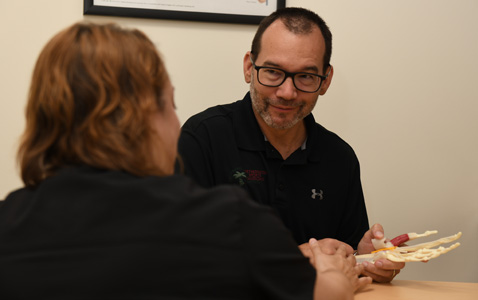Cubital Tunnel Syndrome
![]() Cubital Tunnel Syndrome is a condition caused by pressure on the ulnar nerve at the elbow. When a nerve is compressed, it cannot function properly. The Ulnar Nerve carries signals for sensation in one half of our ring finger, our small finger and to our muscles that perform fine hand movements. Individuals with Cubital Tunnel Syndrome have difficulty handling objects and performing gripping motions. Individuals may feel pain, numbness, and a “tingly” sensation.
Cubital Tunnel Syndrome is a condition caused by pressure on the ulnar nerve at the elbow. When a nerve is compressed, it cannot function properly. The Ulnar Nerve carries signals for sensation in one half of our ring finger, our small finger and to our muscles that perform fine hand movements. Individuals with Cubital Tunnel Syndrome have difficulty handling objects and performing gripping motions. Individuals may feel pain, numbness, and a “tingly” sensation.
Symptoms
Cubital Tunnel Syndrome frequently causes numbness and tingling in the ring finger and little finger, and the symptoms may come and go. They may happen more often when your elbow is bent, such as at night when sleeping in one position for an extended period. You may also experience poor finger coordination and a weak grip, which may interfere with activities such as holding objects in your hand, using a keyboard, or playing an instrument. If the Ulnar Nerve compression is not treated, it can cause muscle deterioration and lead to permanent impairment. You should consult your Celebration Orthopaedics hand surgeon if the symptoms of ulnar nerve compression last more than a few weeks and interfere with normal activity.
Causes
Cubital Tunnel Syndrome can result from ulnar nerve compression. Its cause is unknown, but several factors appear to contribute to it. The most common cause appears to be from repeated elbow movements. The flexor carpi ulnaris muscle can press on the ulnar nerve as it runs through the cubital tunnel. The Ulnar Nerve can also become irritated from pressure on the elbow and can occur when the elbow is leaned on or pressed on for long periods of time. Elbow fractures, trauma, bone spurs, swelling, or cysts are additional factors that can lead to Cubital Tunnel Syndrome.
 Treatment Options
Treatment Options
Most cases of Cubital Tunnel Syndrome respond to non-surgical treatments, which typically include activity restriction, rest, and pain relief. You should avoid repetitive elbow movements and avoid leaning or putting pressure on the elbow. You should refrain from the movements and postures that cause discomfort and take frequent breaks to rest when performing such movements. Elbow splints may be worn to keep your arm straight, especially while sleeping. Anti-inflammatory medications may provide pain relief.
Your Celebration Orthopaedics hand surgeon may prescribe occupational therapy. Our occupational therapists focus on gentle exercises to help the ulnar nerve slide through the Cubital Tunnel. The exercises may help keep the forearm and wrist muscles healthy while preventing joints from becoming stiff.
If the strategies listed above do not help improve the condition, if the nerve is very compressed, or if there is muscle wasting, your Celebration Orthopaedics hand surgeon may recommend surgery to take pressure off the nerve. Most often, the surgery is done around the elbow, but it can be done at the wrist if that is the place of the compression. Sometimes, the nerve is compressed in both places, so surgery is done at both the elbow and the wrist.
More commonly, the nerve is moved from its place behind the elbow to a new place in front of the elbow. This is called an anterior transposition of the ulnar nerve. The nerve can be moved to lie under the skin and fat but on top of the muscle (subcutaneous transposition), within the muscle (intermuscular transposition) or under the muscle (submuscular transposition). There are many factors that go into deciding where the nerve is moved.
Recovery
If you require surgery for Cubital Tunnel Syndrome, it may take several months to recover, but generally, you can achieve good results. Individuals with muscle or nerve damage may take a longer time to recover. Nerves can take a long time to heal, regenerating at about one millimeter a day. For individuals with severe nerve or muscle damage, complete healing may not be possible, and they may have some symptoms even after surgery.
